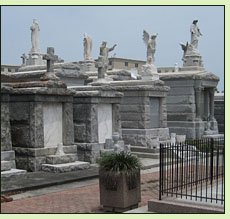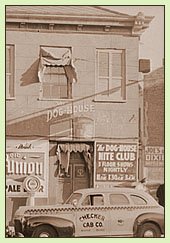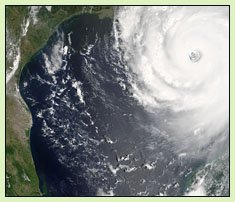Travel by Novel: New Orleans

Best Historical Novels for Travelers to New Orleans
Jump to:
Prehistoric Louisiana
The Eighteenth Century
The Nineteenth Century
The Twentieth Century
Twenty-First-Century New Orleans Before Katrina
Hurricane Katrina
Mysteries
Novels for Teens
 The city of New Orleans was founded by French explorers in 1718 on the banks of the Mississippi River and named for the French regent, Philippe d'Orléans. The French were not the first people to settle in the Louisiana bayous, though. When they arrived, the Chitimacha Indians had been living in the area for some 1200 years. New Orleans passed from French to Spanish control and then back to the French until in 1803 Napoleon Bonaparte, desperate for cash to fund his European conquests, sold France's extensive holdings in North America to the United States in the Louisiana Purchase.
The city of New Orleans was founded by French explorers in 1718 on the banks of the Mississippi River and named for the French regent, Philippe d'Orléans. The French were not the first people to settle in the Louisiana bayous, though. When they arrived, the Chitimacha Indians had been living in the area for some 1200 years. New Orleans passed from French to Spanish control and then back to the French until in 1803 Napoleon Bonaparte, desperate for cash to fund his European conquests, sold France's extensive holdings in North America to the United States in the Louisiana Purchase.
The Creole influence in New Orleans is a heritage of its early French and Spanish settlers, but also of the descendants of African slaves. Throughout the slave-owning South, white men often took black mistresses. In French Louisiana, men could legally marry these women and sometimes did. A thriving population of free men and women of color developed in New Orleans. While prejudice existed, the restrictions against them were far less onerous than in other parts of the Deep South. Many were educated and even became wealthy. The distinctive cuisine of New Orleans, with its gumbo, jambalaya and red beans and rice dishes, developed from the blending of European, African and Native American culinary traditions. Jazz was born in New Orleans, a creation of black musicians in New Orleans who adapted African music to European instruments and over time developed new and distinctive musical styles - blues, ragtime and jazz.
New Orleans has seen historic change in our own time with the savage destruction caused by Hurricane Katrina, which hit the city in 2005. Many people left New Orleans after Katrina; the 2010 census reflected a sharp drop in the city's population. Tourism has long been a major contributor to the city's fortunes, and is especially important in the wake of Katrina. While parts of the city remain devastated, the old French Quarter was built on high ground and its historic buildings are still standing, as picturesque as ever.
It's impossible to do justice to the rich history of New Orleans in a few paragraphs. For more, see the History & Heritage page at NewOrleansOnline.com. You may also be interested in a guide on the Domio blog, What to Do in New Orleans.
Prehistoric Louisiana
Click on the title for more information from Powell's Books or another online source.
Kathleen O'Neal Gear and W. Michael Gear, People of the Owl (2003), about a young man in prehistoric Louisiana who inherits his dead brother's wives; #11 in the First North Americans series.
The Eighteenth Century
Click on the title for more information from Powell's Books or another online source.
Thomas B. Costain, High Towers (1949), about a young woman from Montreal who marries a brute instead of the man she loves in order to help her brother keep his position as governor of the New Orleans colony in French Louisiana.
Ben Farmer, Evangeline (2010), about a young Acadian woman, separated from her husband-to-be when the British drive the French out of Canada, who makes a ten-year journey overland to New Orleans in search of him.
Elizabeth Nell Dubus, Cajun (1986), about a family banished from Nova Scotia who settle in Louisiana and rise to wealth and power, and a French family which escapes the Revolution and struggles to rebuild their fortune in Louisiana.
Anne Rice, Interview with the Vampire (1976), about a 200-year-old vampire who began as a young indigo planter in Louisiana distraught over his brother's suicide; #1 in the Vampire Chronicles series, in which the later books have progressively less realistic historical content.
Clare Clark, Savage Lands (2010), about a young woman who goes to French Louisiana in 1704 as part of a group sent to become wives for the colonists; this is actually set across the Mississippi River from New Orleans in what is now Mobile, Alabama, but the vivid descriptions of the swampy coastal land and the earliest French colonists make it interesting reading for travelers to the New Orleans side of the river. Review or Author Interview
Isabel Allende, Island Beneath the Sea (2010), about a slave and her master who flee the Haitian Revolution in 1793 and go to New Orleans. Review
The Nineteenth Century
Click on the title for more information from Powell's Books or another online source.
 George Washington Cable, The Grandissimes (1880), about a Creole family in New Orleans in the early nineteenth century shortly after the Louisiana Purchase made the city a U.S. rather than a French possession; an early indictment of racial inequities.
George Washington Cable, The Grandissimes (1880), about a Creole family in New Orleans in the early nineteenth century shortly after the Louisiana Purchase made the city a U.S. rather than a French possession; an early indictment of racial inequities.
Kate Chopin, The Awakening (1899), a classic novel, contemporary at the time it was written, about an unhappily married New Orleans woman who is unfaithful to her husband while spending the summer on the coast.
Sara Donati, Queen of Swords, about a woman and her family in Florida and New Orleans during the War of 1812, #5 in the Wilderness series.
Robert Hicks, A Separate Country (2009), about the Confederate general John Bell Hood in the years after the Civil War when, crippled by a wounded arm and the loss of a leg, he married again and settled in New Orleans, a hotbed of yellow fever and racial tension.
Grace King, Monsieur Motte (1888), about a young woman orphaned during the Civil War who is about to graduate from an exclusive New Orleans boarding school where her fees have been paid by a mysterious uncle she has never met; a contemporary novel written in the late nineteenth-century that offers a critique of race relations and a sympathetic portrayal of mixed-race Creoles.
Louis Maistros, The Sound of Building Coffins (2009), a surrealistic novel about Vodou, death and redemption in late nineteenth-century New Orleans. Review
Belva Plain, Crescent City (1984), about an unhappily married Jewish woman in New Orleans who falls in love with another man during the Civil War era.
Anne Rice, The Feast of All Saints (1979), about free people of color in early nineteenth century New Orleans.
Frank Yerby, The Foxes of Harrow (1946), about a man who arrives in New Orleans in 1825, gambles his way to ownership of a magnificent plantation, and has a child by each of three women: his wife, her sister, and his black mistress.
Frank Yerby, The Vixens (1947), about the conflicts between the defeated aristocracy of the South and its liberated former slaves; sequel to The Foxes of Harrow.
Frank Yerby, The Girl from Storyville: A Victorian Novel (1972), about a young woman who seems fated to follow the mother who abandoned her into the life of a New Orleans prostitute.
The Twentieth Century
Click on the title for more information from Powell's Books or another online source.

Lesley Pearse, Belle (2011), about a fifteen-year-old innocent who has grown up in a Seven Dials brothel and must migrate to New Orleans after she is sold into prostitution in Paris; set at the beginning of the century.
Frances Parkinson Keyes, Dinner at Antoine's (1948), a mystery about a woman visiting New Orleans during Mardi Gras, during which one of the wealthy local women she is introduced to is murdered; a contemporary novel in the 1940s when it was written.
Walker Percy, The Moviegoer (1961), a literary novel about a New Orleans stockbroker during Mardi Gras week in the 1950s; a contemporary novel at the time it was written.
Robert Stone, A Hall of Mirrors (1967), about an out-of-work musician who comes to New Orleans in 1962 and accepts a job at a right-wing radio station.
John Kennedy Toole, A Confederacy of Dunces (1980), about a fat, flatulant scholar of medieval philosophy who works at a pants factory and later as a hot dog vendor in New Orleans in the 1960s.
Twenty-First-Century New Orleans Before Katrina
Click on the title for more information from Powell's Books or another online source.
Poppy Z. Brite, Liquor (2004), about two chefs who decide to open a new restaurant in which all the dishes will be alcohol-based.
Nora Roberts, Midnight Bayou (2001), about a man who buys an old house in New Orleans and begins experiencing flashbacks to dark events that occurred there a century earlier.
Hurricane Katrina

Click on the title for more information from Powell's Books or another online source.
Christopher Golden and Tim Lebbon, The Map of Moments (2009), a fantasy horror novel about a man who returns to New Orleans after Hurricane Katrina for the funeral of his former girlfriend.
Tom Piazza, City of Refuge (2008), about a black family and a white family in New Orleans and their experiences during Hurricane Katrina.
Mysteries
Click on the title for more information from Powell's Books or another online source.
Barbara Hambly, A Free Man of Color (1979), about a Creole physician and music teacher in 1830s New Orleans who decides to investigate the murder of a beautiful octoroon when the authorities are reluctant to do so; #1 in the Benjamin January series.
Barbara Hambly, Fever Season (1998), about a Creole physician who investigates the murder of a slave's lecherous master in order to clear her of suspicion amid an epidemic in 1833 New Orleans; #2 in the Benjamin January series.
Barbara Hambly, Graveyard Dust (1999), about a Creole physician who discovers he is the target of a voodoo curse when he attempts to clear his sister of a murder charge in 1834 New Orleans; #3 in the Benjamin January series.
Barbara Hambly, Sold Down the River (2000), about a Creole physician who reluctantly agrees to investigate a case of murder and arson on the plantation of his vicious former owner; #4 in the Benjamin January series.
Barbara Hambly, Die Upon A Kiss (2001), about a Creole physician who investigates when a production of Shakespeare's Othello during Mardi Gras leads to violence in 1835 New Orleans; #5 in the Benjamin January series.
Barbara Hambly, Wet Grave (2002), about a Creole physician who investigates the murder of the once-beautiful mistress of a corsair in 1835 New Orleans; #6 in the Benjamin January series.
Barbara Hambly, Days of the Dead (2003), about a Creole physician who travels to Mexico City in 1835 to try to free a consumptive fellow musician of the charger of murdering the son of a prominent land owner; #7 in the Benjamin January series.
Barbara Hambly, Dead Water (2004), a free man of color investigates a mystery in 1830s New Orleans; #8 in the Benjamin January series.
Ed Kovacs, Storm Damage (2011), a contemporary mystery about a former policeman, now a P.I., investigating the murder of a man whose body was swept away during Hurricane Katrina; #1 in the Cliff St. James mystery series.
Ed Kovacs, Good Junk (2012), a contemporary mystery about a private detective helping the police investigate the murder of a U.S. government "black projects" engineer; #2 in the Cliff St. James mystery series.
Ed Kovacs, Burnt Black (2013), a contemporary mystery about a homicide detective and his partner investigating a series of ritualistic deaths, possibly connected with a secretive occult group; #3 in the Cliff St. James mystery series.
Owen Parry, Rebels of Babylon (2005), about a confidential aide to President Lincoln who must investigate a spate of murders in 1863 Civil War New Orleans; #6 in the Abel Jones series.
John Dickson Carr, Papa La-Bas (1968), about a senator who investigates a murder in 1858 New Orleans.
John Dickson Carr, Deadly Hall (1971), about a novelist who returns to New Orleans, his boyhood home, in 1927 to investigate a murder connected with a friend's inheritance.
David Fulmer, Chasing the Devil's Tail (2001), about a Creole detective investigating murders of prostitutes in New Orleans' Storyville district in 1907 amid the birth of jazz; #1 in the Storyville mystery series.
David Fulmer, Jass (2005), about a Creole detective investigating the murders of four musicians in New Orleans' Storyville district who played a new type of music known as "jass"; #2 in the Storyville mystery series.
David Fulmer, Rampart Street (2006), about a Creole detective trying to find out who murdered a wealthy gentleman in an unsavory part of town as political pressure mounts for him to abandon the investigation; #3 in the Storyville mystery series.
David Fulmer, Lost River (2008), about a Creole detective who agrees to investigate a series of murders in Storyville brothels when a madam appeals to him for help; #4 in the Storyville mystery series.
James Sallis, The Long-Legged Fly (1992), about a black detective who investigates missing-person cases in New Orleans in 1964, 1970, 1984 and 1990; #1 in the Lew Griffin mystery series.
James Sallis, Moth (1993), about a former detective in New Orleans who, after a friend dies, decides to search for the friend's runaway daughter; #2 in the Lew Griffin mystery series.
James Sallis, Black Hornet (1994), about a black New Orleans man in the 1960s who is standing beside the white victim of a sniper and decides it is his responsbility to avenge her death; #3 in the Lew Griffin mystery series.
James Sallis, Eye of the Cricket (1997), about a black New Orleans detective who looking for three missing men when a derelict in the hospital claims to be him; #4 in the Lew Griffin mystery series.
James Sallis, Bluebottle (1999), about a New Orleans man who comes out of a year-long coma and who shot him while he was leaving a music club with a white woman and why; #5 in the Lew Griffin mystery series.
James Sallis, Ghost of a Flea (2000), about a New Orleans man whose policeman friend is shot at the scene of a robbery; #6 and last in the Lew Griffin mystery series.
Novels for Teens
Lois Duncan, Locked in Time (1985), about a seventeen-year-old girl in modern times who goes to a Louisiana plantation with her father to live with his new wife and her children, who have an odd link to a past century.
Paula Morris, Ruined (2009), about a fifteen-year-old girl of the present sent to live with her aunt in New Orleans where she makes friends with a girl she meets in a cemetery and discovers she is a ghost who lived in 1853.
Paula Morris, Unbroken (2014), about a girl of the present who returns to New Orleans and encounters the ghost of a boy who wants her to solve a century-old murder mystery; sequel to Ruined.
Cheryl Zach, Winds of Betrayal (1995), historical romance about a seventeen-year-old Creole girl in New Orleans during the Civil War who falls for another man after seeing her fiancé with another woman.
Top of Page
Back to Travel by Novel Directory
Enjoy this page? Please pay it forward. Here's how...
Would you prefer to share this page with others by linking to it?
- Click on the HTML link code below.
- Copy and paste it, adding a note of your own, into your blog, a Web page, forums, a blog comment, your Facebook account, or anywhere that someone would find this page valuable.